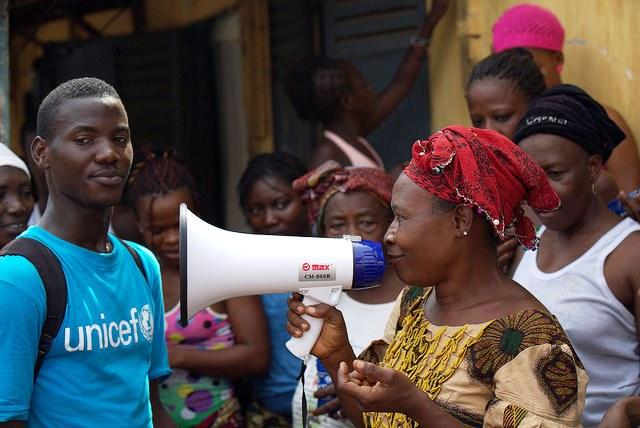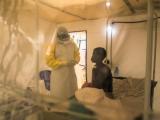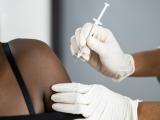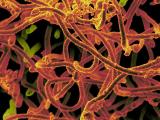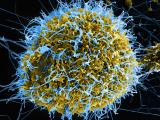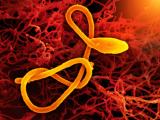With the Ebola response shifting into its next phase—building capacity to detect every case—the overall number of infections in West Africa's outbreak region continued to fall, but case incidence rose in Guinea, a country that has seen levels rise and fall multiple times in the epidemic.
In another development, researchers today published new Ebola vaccine findings from a clinical trial conducted in the United Kingdom, which showed that the highest of the three doses of the ChAd3 vaccine prompted the biggest immune response.
In its latest epidemiologic update on the outbreak today, the World Health Organization (WHO) said the total in the three hardest hit countries is at 22,057 confirmed, probable, and suspected as of Jan 25, with the number of deaths reaching 8,795. Over the past week the number of lab-confirmed cases grew by 30 in Guinea, 4 in Liberia, and 65 in Sierra Leone.
Community resistance still a problem in parts of Guinea
Guinea's 30 confirmed cases are up from 20 reported the week before, according to the WHO. Half of the cases are from Forecariah district, an area in the western part of the country that borders Sierra Leone. The WHO added that high levels of community resistance to Ebola response steps have been reported in the district, pointing to a need for better community engagement there.
Outbreak responders are having a tougher time grappling with community resistance in Guinea than in the other two countries. The WHO said 27 of Guinea's subprefectures reported at least one security incident or refusal to cooperate over the past week, compared with two districts in Liberia and four in Sierra Leone.
A handful of cases were reported from the capital, Conakry, with Kissidougou and Macenta districts reporting their first cases in 21 days. Also, Mali district, which borders Senegal, reported its first confirmed case, a man who had traveled from Liberia. Senegal recently reopened its land borders with Guinea.
One Ebola marker that the WHO is watching closely, especially as the response enters its next phase, is the percentage of new confirmed cases among registered contacts of case-patients. The target is for 100% of new cases to arise among known contacts, a measure that tells responders how well each chain of transmission is tracked and stamped out.
In Guinea, 30% of newly confirmed cases were among known contacts, a drop from 53% the previous week. The WHO said the decline might be linked to the high number of new cases in Forecariah. For comparison, 50% of Liberia's newest confirmed cases were among known contacts. The data aren't yet available for Sierra Leone.
Sierra Leone cases continue decline
Meanwhile, Sierra Leone's cases are decreasing rapidly, with slightly fewer than half as many cases as the week before. The western part of the country is still the main hot spot, where the capital Freetown reported 20 of the country's new cases last week and nearby Kambia and Western districts reporting 10 and 16 new cases, respectively.
Kambia district, which borders Guinea's Forecariah hot spot, has reported Ebola case increases over the past 2 weeks, the WHO reported.
An area in the eastern part of Sierra Leone, Kono district, that has reported several cases over the past several weeks reported only 1 case last week, compared with 13 the previous week.
Few cases in Liberia
In Liberia, all four of the new confirmed cases were from Montserrado County, an area that includes Monrovia, the WHO reported. Nearby Bomi district reported three probable cases.
Among all three of the countries, only two new confirmed Ebola cases are in healthcare workers, both of them from Liberia. The new infections lift the overall number in the main outbreak countries to 816, which includes 488 deaths. The WHO added that all healthcare facilities are being assessed for compliance with minimum infection prevention and control standards; the target is for 100% of facilities to meet the goals. The agency said it will have information soon on the proportion of facilities that are compliant.
Vaccine developments progress
A small trial of an Ebola vaccine developed by GlaxoSmithKline (GSK) and the National Institutes of Health (NIH) conducted in the United Kingdom found that the highest of three dose levels tested provided the best immune response, providing a possible clue about the dose that might be tested in the first large-scale clinical trial in Liberia, slated to begin soon.
The results, published today in the New England Journal of Medicine, are the second set of findings to be published on the ChAd3 vaccine, which uses a modified chimpanzee adenovirus. Last week GSK announced that the first batches of vaccine were on their way to Liberia.
Ebola vaccines that are currently in clinical trials are proceeding at an unprecedented pace. At a WHO expert meeting earlier this month, scientists laid out plans for the next testing step—phase 3 studies to see if the vaccines work in the outbreak area. They also hinted there could be different roles for different Ebola vaccine formulations; for example, it's possible that a single-dose vaccine with shorter immunity could be used to smother Ebola flare-ups while a prime-boost vaccine strategy might provide more durable immunity, perhaps for those at highest risk, such as healthcare workers.
GSK had said it selected a dosage level for the Liberian trial but didn't specify the level. The company said it expected trials to begin soon. WHO experts who met earlier this month had estimated a late-January start for the phase 3 efficacy trials in the outbreak region. However, as case levels continue to drop dramatically in all three of the hardest hit countries, especially Liberia, scientists are worried that the conditions will delay the trials or make them impossible to conduct.
A second vaccine, VSV-EBOV, developed by Canadian researchers and licensed by NewLink Genetics and Merck is also slated to be tested in Liberia's large-scale trial. VSV-EBOV uses an Ebola virus protein spliced into a vesicular stomatitis virus.
The ChAd3 vaccine is currently being tested in five small phase 1 studies in the United Kingdom, United States, Switzerland, and Mali. Researchers published the first trial results in late February. The 20-person study, launched in early September at the NIH Clinical Center in Bethesda, Md., involved a bivalent version of the vaccine that contains genetic material from the two most lethal Ebola strains, Zaire and Sudan.
In that trial, investigators tested two doses—2 X 1010 viral particles and 2 X 1011 viral particles. Antibodies were detected in all volunteers 4 weeks after vaccination, but levels were higher in those who got the higher dose. The researchers found that the vaccine also induced T-cell immune response, which again was greater at the higher dose.
New study results
The study in today's New England Journal of Medicine involves a monovalent version of the ChAd3 vaccine that includes genetic material from the Zaire strain, which is responsible for West Africa's outbreak. The authors noted that the development of the bivalent version of the vaccine was mainly targeted to biodefense needs and was originally intended for use with an MVA booster dose. However, results using the monovalent Zaire version of the vaccine were encouraging in macaques, and the monovalent vaccine takes half the manufacturing time as the bivalent version, which has influenced its selection for testing.
The trial, conducted by a team from the University of Oxford and launched in August, included 60 healthy adults from the local area. Groups of 20 study participants received a single dose containing 1 of 3 levels: 1 X 1010 viral particles, 2.5 X 1010 viral particles, and 5 X 1010 viral particles. Scientists looked at the vaccine's safety over a 4-week period and measured antibody and T-cell responses.
No serious safety concerns were seen at any of the dose levels. Antibody responses were highest in the group receiving the highest dose; that group also had a 100% response rate for T cells, peaking at day 14.
Though the team detected antibody and T-cell responses at all dose levels tested, the responses they saw were lower than those seen in the earlier macaque studies.
In their analysis, the group wrote that if greater immunogenicity is needed, an option would be to use a higher dose of the vaccine, based on results seen for the higher dose used in the earlier trial of the bivalent vaccine. They added that another option for prompting a higher response would be to boost the vaccine with an MVA vector encoding the same antigen; a similar approach in macaques increased antibody activation by a factor of 30, increased the frequency of antigen-specific T cells by a factor of 5, and improved the durability of vaccine efficacy.
They concluded that the safety and immunogenicity they found for ChAd3 should encourage further study of the vaccine used alone or in prime-boost strategies and that ChAd3 should be considered for phase 3 trials in the outbreak countries in early 2015.
See also:
Jan 28 WHO situation report
Jan 28 N Engl J Med abstract
Nov 26, 2014, CIDRAP News story "First human trial of NIH-GSK Ebola vaccine shows promise"
